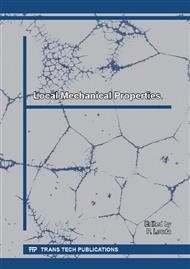[1]
Mitura S., Niedzielski P, Walkowiak B. (Eds. ), Nanodiam. New technologies for medical applications: studying and production of carbon surfaces allowing for controllable bioactivity. Warszawa, PWN, 2006, ISBN 978-83-01-14951-2.
Google Scholar
[2]
Ratner B. Biomaterials science: an introduction to materials in medicine. 2nd ed. Amsterdam: Elsevier, 2004, p.851. ISBN 01-258-2463-7.
Google Scholar
[3]
R.F. Bunshah (Ed. ), Handbook of Hard Coatings; Deposition Technologies, Properties and Applications, Noyes publications, Park ridge, New Jersey, USA, (2001).
Google Scholar
[4]
Niinomi M., Metallurgical and Materials Transactions A. March 2002. Vol. 33 A. pp.477-486.
Google Scholar
[5]
M.M. Stack, Y. Purandare P. Hovsepian, Surf. Coat. Technol. 188–189 (2004) 188.
Google Scholar
[6]
Quirynen M, van der Mei HC, Bollen CM, Schotte A, Marechal M, Doornbusch GI, et al. Journal of Dental Research 1993; 72: 1304–9.
DOI: 10.1177/00220345930720090801
Google Scholar
[7]
Bollen CM, Lambrechts P, Quirynen M. Dental Materials : Official Publication of the Academy of Dental Materials 1997; 13: 258–269.
Google Scholar
[8]
Juárez-Moreno JA, Ávila-Ortega A, Oliva AI, Avilés F, Cauich-Rodríguez JV. Effect of wettability and surface roughness on the adhesion properties of collagen on PDMS films treated by capacitively coupled oxygen plasma. Applied Surface Science 2015; 349: 763–73. doi: 10. 1016/j. apsusc. 2015. 05. 063.
DOI: 10.1016/j.apsusc.2015.05.063
Google Scholar
[9]
Roşu RA, Şerban V-A, Bucur AI, Dragoş U. Deposition of titanium nitride and hydroxyapatite-based biocompatible composite by reactive plasma spraying. Applied Surface Science 2012; 258: 3871–6. doi: 10. 1016/j. apsusc. 2011. 12. 049.
DOI: 10.1016/j.apsusc.2011.12.049
Google Scholar
[10]
Bauer S, Schmuki P, Mark K von der, Park J. Engineering biocompatible implant surfaces: Part I: Materials and surfaces. Progress in Materials Science 2013; 58: 261–326. doi: 10. 1016/j. pmatsci. 2012. 09. 001.
DOI: 10.1016/j.pmatsci.2012.09.001
Google Scholar
[11]
Serro A. P. et al. A comparative study of titanium nitrides TiN, TiNbN and TiCN as coatings for biomedical applications. Surface & Coating Technology 2009, 203 (24), 3701–3707.
DOI: 10.1016/j.surfcoat.2009.06.010
Google Scholar
[12]
Bakalova T. Et al. Influence of coating process parameters on the mechanical and tribological properties of thin films LMP 2015 (In press).
Google Scholar


